Introduction
Nonwoven landscape fabric has become a favored tool among gardeners, recognized for its efficacy in weed control and soil protection. This material is designed to allow water and nutrients to penetrate the soil while preventing the growth of unwanted vegetation. But is it the optimal choice for your garden? This blog post delves into this question by examining the effectiveness, cost, and environmental impact of nonwoven landscape fabric. We aim to provide a comprehensive overview to help you make an informed decision about incorporating this material into your gardening practices.
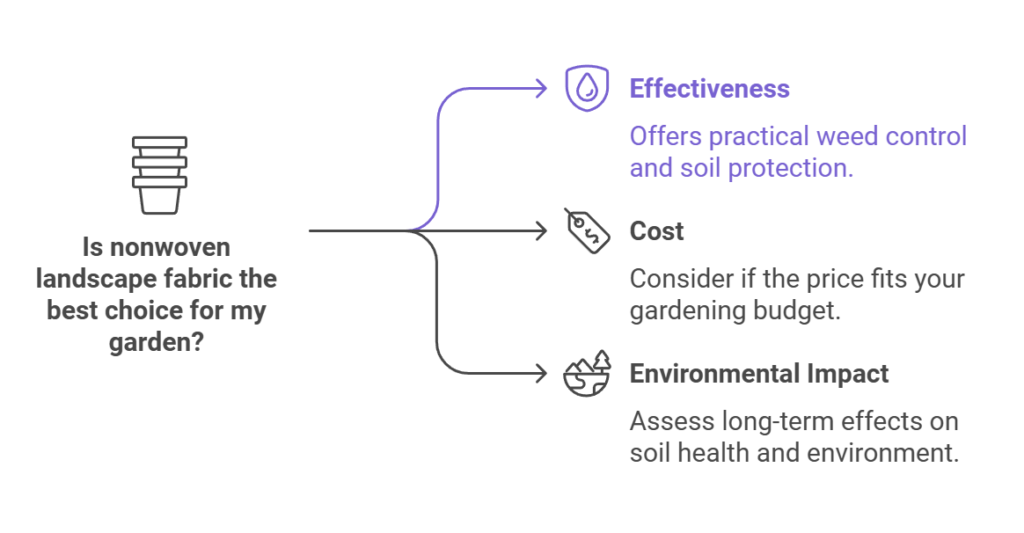
When considering nonwoven landscape fabric, it’s essential to weigh its benefits against potential drawbacks. While it offers a practical solution for managing garden weeds, its long-term impact on soil health and the environment requires careful consideration. In the following sections, we will explore these various aspects in detail, providing you with the necessary information to determine if nonwoven landscape fabric aligns with your gardening goals.
What is Nonwoven Landscape Fabric?
Nonwoven landscape fabric is a type of material specifically designed for use in gardening and landscaping to control weeds, retain soil moisture, and support healthy plant growth. Unlike woven fabrics, nonwoven landscape fabric is created through a process called spunbonding, where synthetic fibers are bonded together using heat, chemicals, or mechanical methods rather than weaving. This results in a durable, breathable fabric that offers excellent water and air permeability, which is essential for maintaining soil health.
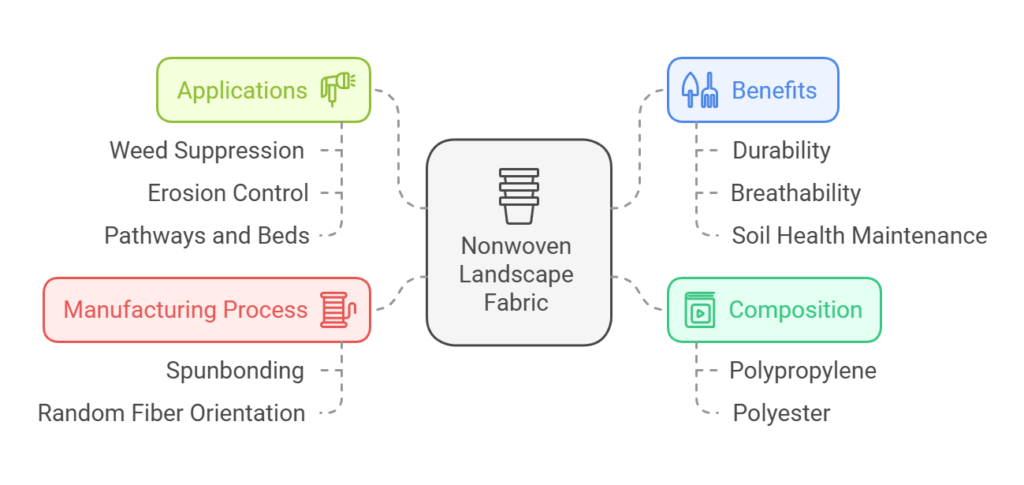
The primary materials used in nonwoven landscape fabric production are typically polypropylene or polyester. These synthetic fibers are chosen for their strength, resistance to biological degradation, and ability to withstand varying weather conditions. During the manufacturing process, the fibers are laid out in a random pattern to create a uniform sheet. This randomness in fiber orientation contributes to the fabric’s strength and its ability to resist tearing and puncturing.
Nonwoven landscape fabric is commonly utilized in various gardening and landscaping applications. Its primary use is weed suppression, as the fabric acts as a physical barrier that prevents weeds from growing while still allowing water, air, and nutrients to penetrate the soil. Additionally, this fabric is often placed under mulch, gravel, or other ground covers to enhance their effectiveness and prolong their lifespan. It is also used for erosion control on slopes or in areas with loose soil, providing a stable foundation for plant roots and preventing soil displacement.
Moreover, nonwoven landscape fabric can be employed in garden pathways, flower beds, and vegetable gardens to reduce maintenance efforts and improve plant health. By keeping weeds at bay and maintaining consistent soil moisture levels, this fabric ensures that plants receive the nutrients they need to thrive. Its versatility and durability make nonwoven landscape fabric a popular choice among gardeners and landscapers looking to create and maintain beautiful, healthy outdoor spaces.
Advantages of Using Nonwoven Landscape Fabric
Nonwoven landscape fabric offers numerous benefits that make it a popular choice among gardeners and landscapers alike. One of the primary advantages is its effectiveness in weed control. By acting as a barrier, nonwoven landscape fabric significantly reduces the growth of unwanted weeds, minimizing the need for herbicides and manual weeding. This not only saves time and effort but also promotes a healthier garden environment.

Another key benefit is moisture retention. Nonwoven landscape fabric helps to maintain soil moisture by reducing evaporation, ensuring that plants have a consistent supply of water. This is particularly beneficial during dry spells, as it reduces the need for frequent watering and supports plant health. Additionally, the fabric’s design allows for efficient water drainage, preventing waterlogging and root rot.
Soil erosion prevention is another notable advantage. Nonwoven landscape fabric stabilizes the soil, reducing erosion caused by wind and water. This is especially important in areas with sloped terrain or heavy rainfall, where soil displacement can be a significant issue. By keeping the soil in place, the fabric helps maintain the structure and fertility of the garden bed.
Durability is a hallmark of nonwoven landscape fabric. Made from high-quality synthetic materials, it is resistant to tearing and puncturing, ensuring long-lasting performance. This durability means that the fabric can withstand various weather conditions and heavy foot traffic, providing reliable protection for years.
The ease of installation is another attractive feature. Nonwoven landscape fabric is lightweight and can be easily cut to fit any garden shape or size. Its flexibility makes it simple to work around existing plants, and securing it in place with landscape staples is straightforward.
Finally, nonwoven landscape fabric allows for air and water permeability. Unlike plastic sheeting, this fabric permits essential nutrients, air, and water to reach the soil and plant roots. This permeability ensures that plants receive the necessary elements for growth while still benefiting from the protective qualities of the fabric.
Disadvantages and Limitations
While nonwoven landscape fabric offers several benefits, it is essential to consider its potential drawbacks to make an informed decision for your garden. One significant concern is the environmental impact. Nonwoven landscape fabric is often made from synthetic materials like polypropylene, which are not biodegradable. Over time, these materials can contribute to plastic pollution, posing a long-term environmental threat.
Another critical issue is soil compaction. Nonwoven landscape fabric can restrict the natural movement of air, water, and nutrients into the soil. This restriction can lead to soil compaction, negatively affecting root growth and overall plant health. Compacted soil reduces water infiltration and drainage, creating an environment less conducive to vigorous plant growth.
Moreover, nonwoven landscape fabric is not a permanent solution. Its lifespan can be limited, especially when exposed to harsh weather conditions and UV radiation. Over time, the fabric may degrade, tear, or become less effective at controlling weeds. This deterioration necessitates periodic replacement, increasing maintenance efforts and costs.
Additionally, while nonwoven landscape fabric can significantly reduce weed growth, it is not foolproof. Weeds can still emerge through the fabric’s seams, holes, or any areas where the fabric has been compromised. Persistent and aggressive weed species may find ways to penetrate the fabric, requiring continued vigilance and manual weeding efforts.
In summary, while nonwoven landscape fabric offers several advantages, it is crucial to weigh these against its potential disadvantages. Environmental impact, soil compaction, limited lifespan, and incomplete weed control are essential factors to consider when deciding whether nonwoven landscape fabric is the best choice for your garden. Balancing these drawbacks with the benefits will help you make a well-rounded decision tailored to your gardening needs.
Comparing Nonwoven Landscape Fabric to Other Weed Control Methods
When considering weed control methods for your garden, several options are available, each with distinct advantages and disadvantages. Nonwoven landscape fabric stands out among these methods, but it is essential to compare it with other common techniques such as organic mulch, plastic sheeting, and manual weeding to determine the best choice for your garden’s needs.
Organic mulch, which includes materials like wood chips, straw, and grass clippings, is a popular weed control method. The primary advantage of organic mulch is its ability to improve soil health by retaining moisture, regulating temperature, and adding nutrients as it decomposes. However, it often requires frequent replenishment and can sometimes harbor pests. Organic mulch is best suited for gardeners who prioritize soil enrichment and are willing to invest time in regular maintenance.
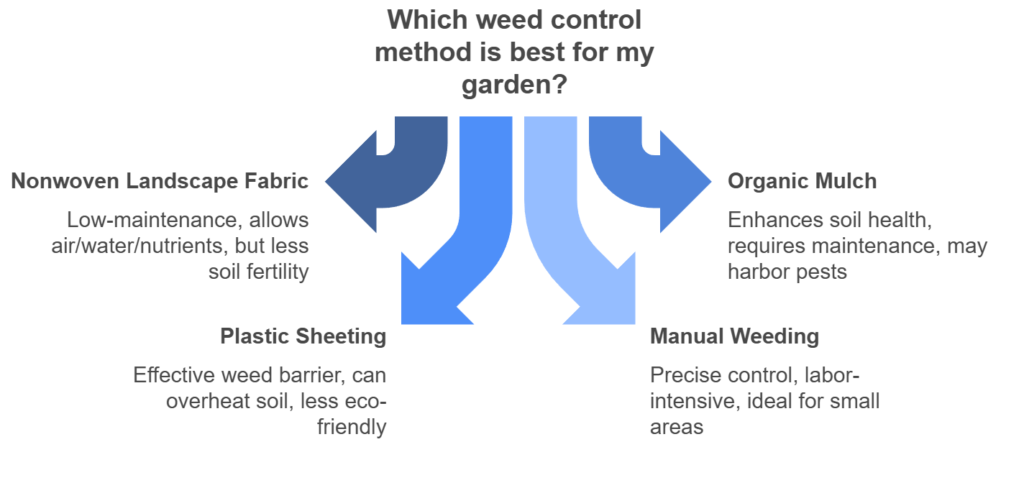
Plastic sheeting, often made from polyethylene, provides an effective barrier against weeds. It prevents sunlight from reaching weed seeds, inhibiting their growth. While it is highly effective in weed suppression, plastic sheeting can lead to several drawbacks. It tends to make the soil overly warm and can restrict water and air flow, potentially harming plant roots. Additionally, it is less environmentally friendly compared to other options. This method is ideal for large-scale agricultural settings or areas where weeds are particularly aggressive and difficult to manage.
Manual weeding is the most labor-intensive method but offers precise weed control. It allows gardeners to target specific weeds without affecting desired plants or soil health. The downside is the significant time and physical effort required, which can be impractical for larger gardens. Manual weeding is best suited for small gardens or areas with minimal weed infestation, where a personalized touch is beneficial.
Nonwoven landscape fabric combines several benefits of the aforementioned methods. It effectively suppresses weeds while allowing air, water, and nutrients to reach the soil. Unlike plastic sheeting, it does not overheat the soil, and unlike organic mulch, it requires minimal maintenance. However, it does not contribute to soil fertility and can be more expensive initially. Nonwoven landscape fabric is ideal for gardeners seeking a low-maintenance, long-term solution that balances weed control with soil health.
Installation Tips and Best Practices
Proper installation of nonwoven landscape fabric is crucial to ensure its effectiveness in your garden. Begin by preparing the soil where the fabric will be installed. Remove any existing weeds, rocks, and debris, and ensure the soil is smooth and level. This preparation step is vital as it helps the nonwoven landscape fabric lay flat and adhere closely to the soil, preventing weed growth underneath.
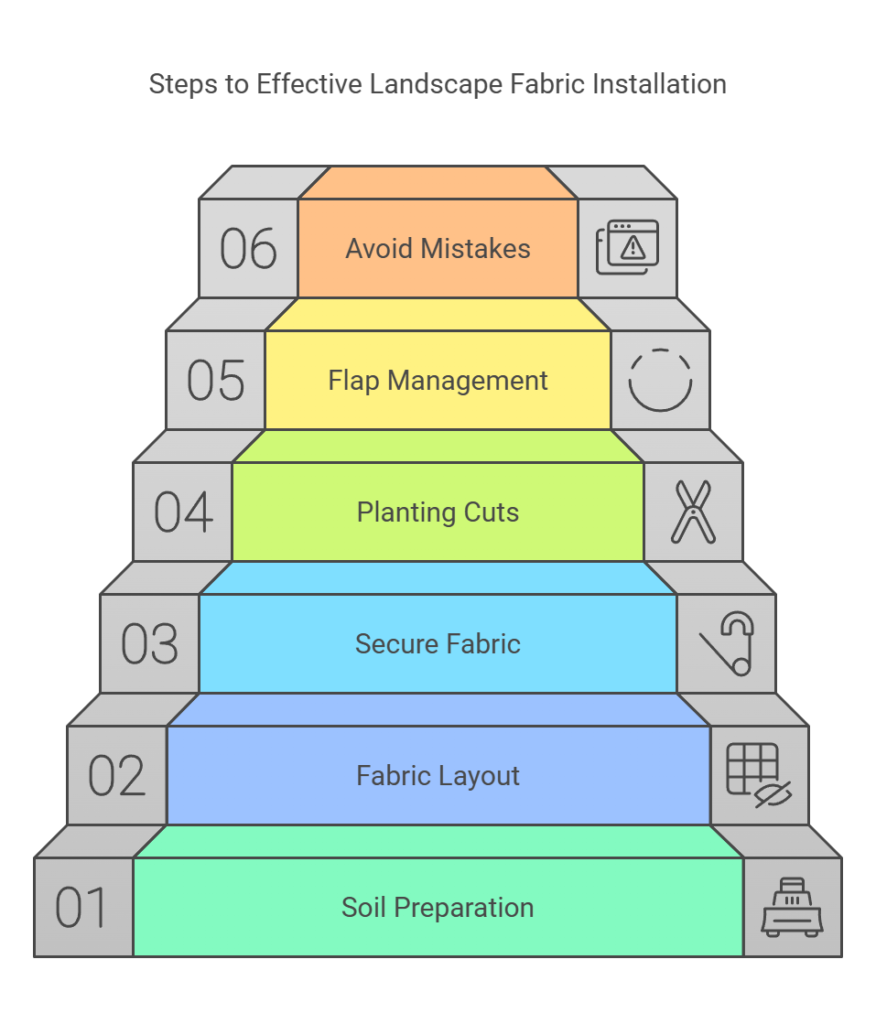
Once the soil is ready, roll out the nonwoven landscape fabric over the prepared area. It’s important to lay the fabric in a way that allows for proper overlap between adjacent sheets, typically about 6-12 inches. This overlap ensures there are no gaps where weeds could potentially break through. To anchor the fabric securely, use landscape staples or pins placed every 1-2 feet along the edges and at the seams. This will prevent the fabric from shifting over time due to wind or water movement.
After securing the fabric, it’s time to make cuts for plants. Use a sharp utility knife or scissors to create X-shaped slits at the locations where you plan to plant. Carefully fold back the flaps created by the cuts and dig a hole for your plant. Once the plant is in place, fold the flaps back down around the base of the plant to minimize exposure of the soil. This method ensures that the nonwoven landscape fabric continues to suppress weeds while allowing your plants to grow.
Avoid common mistakes such as stretching the fabric too tightly, which can cause it to tear, or failing to secure the edges properly, which can lead to weed growth. Additionally, refrain from covering the fabric with too much mulch, as this can prevent water and nutrients from reaching your plants’ roots. By following these installation tips and best practices, you can maximize the benefits of nonwoven landscape fabric in your garden.
Maintenance and Care
Proper maintenance and care are crucial for ensuring the longevity and effectiveness of nonwoven landscape fabric in your garden. Regular inspection is the first step in maintaining your landscape fabric. Periodically check for any signs of damage, such as tears or holes, which can compromise the fabric’s ability to suppress weeds. If you detect any damages, repair them promptly using appropriate patches or by replacing the damaged section altogether.

Cleaning debris off the surface of the nonwoven landscape fabric is another essential aspect of maintenance. Organic matter, such as fallen leaves and twigs, can accumulate over time and potentially degrade the fabric. Carefully remove such debris to prevent any blockage that might hinder water and air passage through the fabric. A gentle sweeping or light brushing can help maintain the fabric’s functionality without causing damage.
Furthermore, adding a layer of mulch on top of the nonwoven landscape fabric can provide additional protection and enhance its performance. Mulch acts as a barrier against ultraviolet rays, reducing the risk of degradation due to sun exposure. It also helps in regulating soil temperature and retaining moisture, which benefits plant growth. Ensure that the mulch layer is evenly spread and maintained at an appropriate thickness, typically around 2-3 inches, to maximize its protective properties.
By adhering to these maintenance practices—regular inspections, debris removal, and adding mulch—you can significantly extend the lifespan of nonwoven landscape fabric in your garden. These measures not only enhance the fabric’s effectiveness in weed suppression but also contribute to the overall health and aesthetics of your garden. Proper care ensures that the nonwoven landscape fabric remains a reliable and efficient choice for your gardening needs.
Frequently Asked Questions
What types of plants are best suited for nonwoven landscape fabric?
Nonwoven landscape fabric is versatile and can be used with a wide range of plants. It is particularly effective for use with ornamental plants, shrubs, and even some types of vegetables. The fabric helps suppress weeds while allowing water and nutrients to reach the roots, making it ideal for garden beds and landscaped areas.
How should I handle tears in the landscape fabric?
If your nonwoven landscape fabric develops tears, it’s important to address them promptly to maintain its effectiveness. Small tears can be patched using additional pieces of fabric, secured with landscape staples. For larger tears, you may need to replace the affected section entirely. Ensuring the fabric is correctly installed and adequately secured from the outset can help minimize the risk of tearing.
Can nonwoven landscape fabric be reused?
Yes, nonwoven landscape fabric can be reused if it remains in good condition after its initial use. When removing the fabric, take care to shake off excess soil and debris before storage. Store it in a dry, cool place to extend its lifespan. Reuse is more feasible with higher-quality fabrics that are more durable and resistant to wear and tear.
How does nonwoven landscape fabric compare to woven fabric?
Nonwoven landscape fabric generally provides better water permeability than its woven counterpart, allowing water and nutrients to penetrate more effectively. Additionally, nonwoven fabric is usually softer and more flexible, making it easier to cut and install around irregular shapes. However, woven fabric may offer greater durability in high-traffic areas. The choice between the two often depends on specific garden requirements and personal preferences.
What maintenance is required for nonwoven landscape fabric?
Maintenance for nonwoven landscape fabric is relatively minimal. Periodically check for any signs of wear, tear, or displacement. Ensure that mulch or other coverings remain evenly distributed over the fabric to protect it from UV radiation and physical damage. Regularly inspect for any weeds that may have penetrated the fabric and remove them promptly to maintain the fabric’s efficacy.
Can I use nonwoven landscape fabric for erosion control?
Nonwoven landscape fabric is effective for erosion control on slopes and embankments. Its ability to allow water penetration while stabilizing soil makes it a suitable choice for preventing erosion. For best results, anchor the fabric securely and cover it with mulch or other stabilizing materials to enhance its performance and longevity.
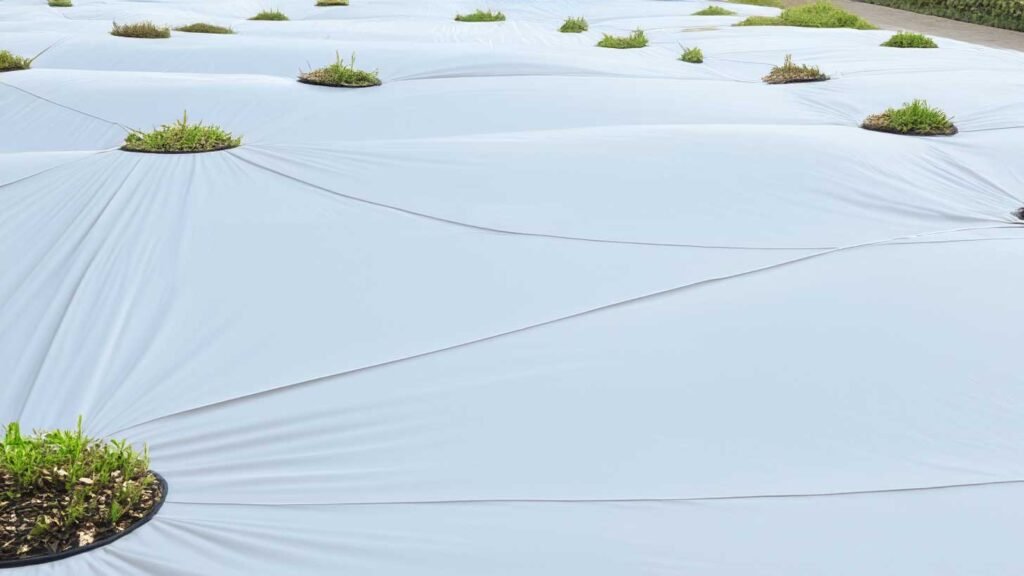

9 Responses
Simplywall You’re so awesome! I don’t believe I have read a single thing like that before. So great to find someone with some original thoughts on this topic. Really.. thank you for starting this up. This website is something that is needed on the internet, someone with a little originality!
Thank you for your kind words! I’m thrilled to hear you enjoyed the post. Your appreciation means a lot. Stay tuned for more content!
Thank you so much, Jack! I’m thrilled to hear you find the blog insightful and relevant. Your feedback is really encouraging. Stay tuned for more content!
allegheny county real estate I like the efforts you have put in this, regards for all the great content.
Thanks for your comment! Glad you like it. 😊
allegheny county real estate I truly appreciate your technique of writing a blog. I added it to my bookmark site list and will
Thank you for your kind words! Glad you find our site useful.
Hi there, I read your new stuff like every week.Your story-telling style is awesome, keep up thegood work!
Thanks a ton! Your consistent support means the world. Glad you enjoy our content. We’ll definitely keep it up!